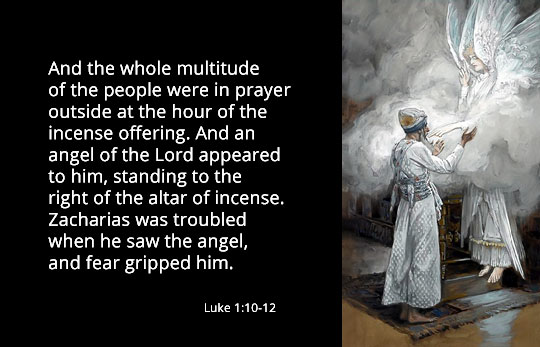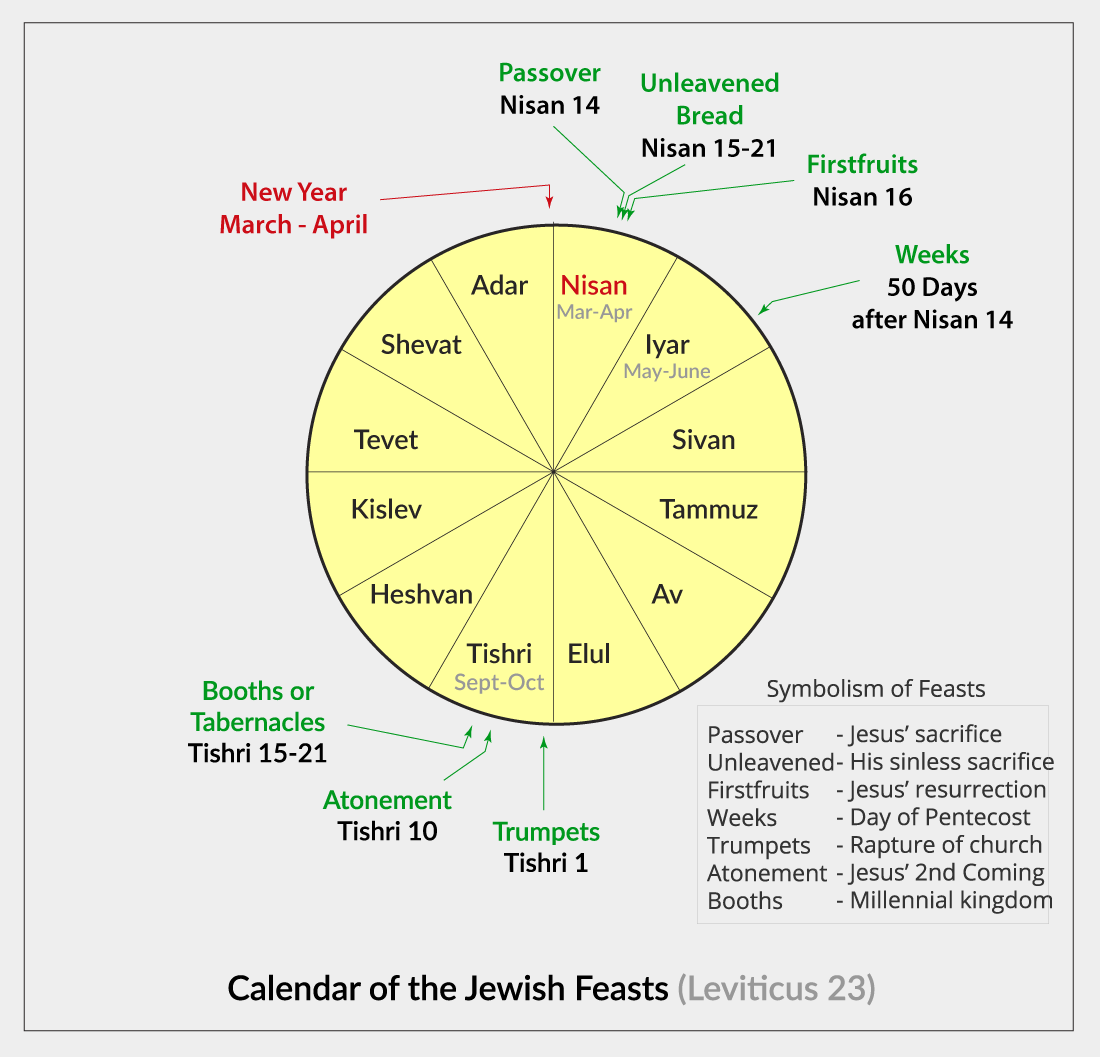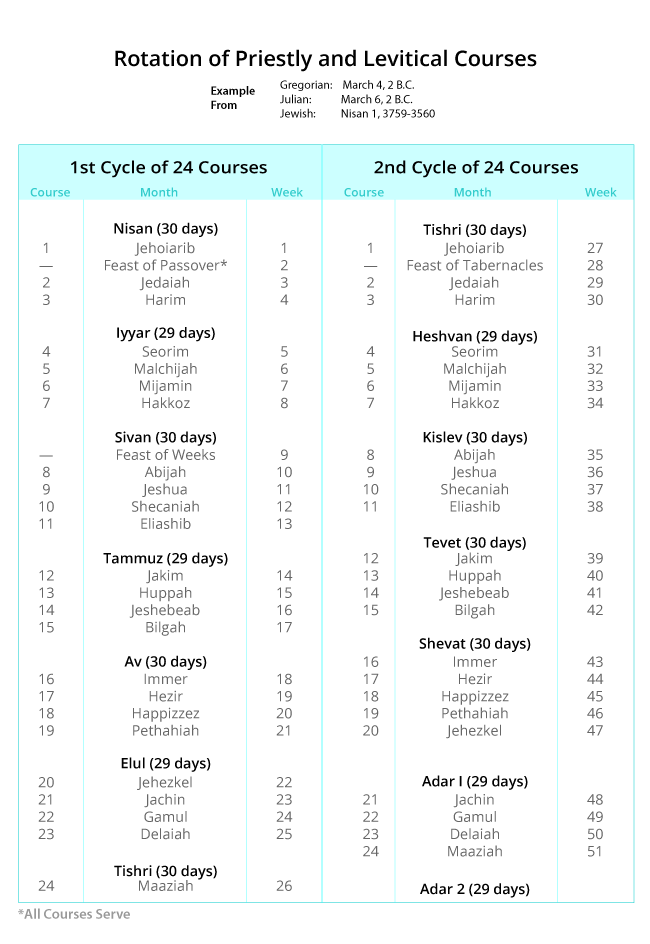Bible Question:
Was Jesus born in September or on December 25? — Zacharias and John the Baptist
Bible Answer:
Contrary to the testimony of many early church writers and the practice of the early church, some claim that Jesus was born in September or October. This article is concerned with the question, “Was Jesus born in September or on December 25?”

Starting With the Birth of John the Baptist
Some suggest that if we start with the birth of John the Baptist, we can arrive at the date of the birth of Jesus Christ. They refer to Luke 1:5-9 which states,
In the days of Herod, king of Judea, there was a priest named Zacharias, of the division of Abijah; and he had a wife from the daughters of Aaron, and her name was Elizabeth. They were both righteous in the sight of God, walking blamelessly in all the commandments and requirements of the Lord. But they had no child, because Elizabeth was barren, and they were both advanced in years. Now it happened that while he was performing his priestly service before God in the appointed order of his division, according to the custom of the priestly office, he was chosen by lot to enter the temple of the Lord and burn incense. Luke 1:5-9 (NASB)
This passage states that Zacharias was a priests of the Abijah division and he was in the temple burning incense. Then in verses 10-17 we are told that an angel visited him and announced the birth of his son, John the Baptist. It is usually assumed that John the Baptist was conceived soon afterwards. Six months later (Luke 1:26) the angel Gabriel announced the conception of Christ to Mary (Luke 1:27-38). Six months is an approximate number, probably accurate to within two weeks. Mayo Clinic states that forty weeks is the average gestation period for a baby.[1] Studies by the U.S. National Library of Medicine have demonstrated that the average gestation period of human babies is 38 weeks.[2] The thirty-eight weeks corresponds to 8.75 months(12 months x 38 weeks/52 weeks). This means that less than fifteen months after the angel’s announcement of the birth of John the Baptist, Christ was born. This is a very good timeline; but the difficulty is in determining the date of the angel’s announcement to Zacharias. The issue is the time when the Abijah division served in the temple. Therefore, we will next examine what Scripture states about the priestly divisions or courses.
Priestly and Levitical Divisions
1 Chronicles 24:1-19 describes how King David decided when the descendants of priests and Levites would serve in the temple. 1 Chronicles 24:4 states that David divided the priests and Levites into twenty-four courses, also called divisions. Then in verses 7-19 we are given the order in which these courses would serve. The decision was made by lot. The course of Abijah would serve eighth in the sequence (1 Chronicles 24:10). 2 Chronicles 23:8 states that each of the twenty-four courses would serve for seven days, from a Sabbath noon to Sabbath noon. Flavius Josephus informs us that the courses served for seven days.[3] Flavius Josephus also describes the creation of the courses and the duration of their service.[4] Nehemiah 12:22-27, 45–46 describes the service of the Levites.
The Hebrew civil calendar started on Tishri 1. The Feast of Trumpets began on that day and the Feast of Tabernacles or Sukkot started on Tishri 15. The religious calendar starts with Nisan 1. The Feast of Passover or Yom Kippur (Exodus 12:2) occurred on Nisan 14, while the Feast of Unleavened Bread started on Nisan 15.[5] In Scripture, the Feast of Tabernacles is often called the Feast of Booths (Zechariah 14:18; John 7:2).

The twenty-four courses would serve for one hundred and sixty-eight days or twenty-four weeks, almost six months. After the twenty-fourth course had served in the temple, the courses cycled again. Since in the nineteen-year Metonic cycle of the Hebrew calendar, twelve years had 354 days and the leap-years had 384 days, the one hundred and sixty-eight days did not cover the entire year.
The Mosaic Law required that all males participate in the Feast of Unleavened Bread, Feast of Weeks and the Feast of Booths or Tabernacles.
Three times in a year all your males shall appear before the LORD your God in the place which He chooses, at the Feast of Unleavened Bread and at the Feast of Weeks and at the Feast of Booths, and they shall not appear before the LORD empty-handed. Deuteronomy 16:16 (NASB)
According to the Mishnah, all of the priests and Levites served by lot during the Feasts of Passover, Pentecost and Tabernacles.[6] Here is an example of the priestly rotation from Nisan 1, 3759-3760 (2 B.C.). Notice that the first cycle extends into the month of Tishri in the year 2 B.C. Also the year 2 B.C. is a leap year. What was the priestly rotation when the additional month of Adar 2 was added?

First View — Zacharias Served on the Day of Atonement
Some claim that Zacharias was visited by the angel on the Day of Atonement (Luke 1:9), which occurs on Tishri 10. Adam English summarizes this view when he writes,
. . . it would seem that he entered the Temple sanctuary on the highest and holiest day of the year, the Day of Atonement, Yom Kippur. There, beside the altar of the Lord, a radiant angel gave news of the child to be born to Elizabeth. The date reckoned for this occurrence is September 24, based on computations from the Jewish calendar in accordance with Leviticus 23 regarding the Day of Atonement.[7]
Then he concludes that Jesus was born on December 25 by counting eighteen months from September 24.
According to Luke 1:26, Gabriel’s annunciation to Mary took place in the “sixth month” of Elizabeth’s pregnancy. Luke repeats the uniqueness of the timing in verse 36. Counting six months from September 24 we arrive at March 25, the most likely date for the annunciation and conception of Mary. Nine months hence takes us to December 25.[8]
However, there are several problems with this view. First, the high priest entered the Holy of Holies on the Day of Atonement to make atonement for his sins and the sins of the people (Leviticus 23:26-44). But Luke 1:5-17 does not tell us that Zacharias was a high priest. Other high priests are mentioned in the gospels, but we are never told that Zacharias was a high priest. Further, Zacharias did not enter the Holy of Holies when he burned incense. The Golden Altar of Incense was positioned before the veil that separated the Holy Place from the Holy of Holies (Exodus 30:6). The Ark of the Covenant was behind the veil. Therefore, this view has a serious problem and, consequently, cannot be accepted.
Second, the date of the Day of Atonement assumes a specific year since the date varies year-to-year as the Hebrew calendar was a lunar calendar. Leviticus 23:26-27 says that the Day of Atonement occurred on Tishri 10. This date varies depending upon the year. But which year did this view choose? A check with the Hebrew calendar reveals that none of the years from 6 B.C. to A.D. 1 give us the date of September 24. This view cannot be supported by the facts.
Second View — Zacharias
Since Zacharias did not burn incense on the Day of Atonement (see above), there are two other occasions when he might have served in the temple. One occasion is sometime after the month of Tishri. On the Feast of Tabernacles, all priests were available for service. This shifts the service for the Abijah course one week to the ninth week in the course rotation cycle. If we calculate the rotation of the priestly service from Tishri 1, the division of Abijah would have served as early as October 27 (5 B.C.) and as late as November 27 (7 B.C.).[9] In the year 2 B.C. he would have served in the week beginning on October 31. If we add fifteen months, we arrive at an approximate birth date range for Jesus between January to February. Jack Finegan provides a similar calculation which suggests that Jesus could have been born between January to February.[10] Since the gestation period of Christ and John the Baptist could have varied by 3 to 5 weeks, Jesus could have been born in December or as late as March.
One of the major arguments against Christ being born in the November to February time period is that sheep would not be in the field in Bethlehem in those months due to the winter cold. This is a commonly raised argument. But Dr. Harry Mulder of the Netherlands has made this comment about the cold winters in Bethlehem.
During the brief Christmas vacation my wife and I traveled from Beirut to Jerusalem . . . On Christmas Eve in Shepherd Field a crowd had gathered to sing Christmas carols. We joined this crowd and took part in the singing. Right near us a few flocks of sheep nestled. Even the lambs were not lacking. It was a moving sight. It is therefore definitely not impossible that the Lord Jesus was born in December.[11]
Obviously, some days within a month might be very cold, but to claim that sheep would not have been in the Bethlehem fields assumes that we know the weather conditions when Christ was born. Therefore, Christ could have been born in the winter months of December to March.
Third View — Zacharias
Since the twenty-four priestly divisions served sequentially twice during a year, the first cycle would start in the month of Nisan and the second one in the month of Tishri. This means that the other possible occasion on which Zacharias could have served in the temple would be sometime after Nisan 1. This rotation of the priestly divisions was calculated from Nisan 1. This is the most likely option since Nisan-to-Nisan was the religious calendar. Tishri-to-Tishri was the civil calendar. Since during the Feast of Unleavened Bread and the Feast of Weeks all priests were available for service, the course of Abijah shifts two weeks to the tenth week in the rotation. If we calculate the rotation of the service of the priestly divisions from Nisan 1, then the division of Abijah could have served as early as the month of May 9 (2 B.C.) and as late as the month of June (7 B.C.). If we count fifteen months from the months of May and June, we arrive at August to early September as the approximate period for Christ’s birth. Jack Finegan provides the calculations which show that this suggests Jesus was born late in July to early September.[12]
Conclusion:
Using this approach we arrive at two times in the year in which Christ could have been born: August to early September or December to March. However, these estimates are unreliable for at least two reasons:
1. Zacharias could have served in the temple during any of the three major feasts, since all twenty-four courses could serve during any of the Feasts of Passover, Pentecost and Tabernacles. If this happened, then the estimated months of Christ’s birth for all the above views considered could have occurred as much as seven weeks earlier. The estimated months of Christ’s birth for view #3 could have occurred as much as one week earlier. If the timelines are shifted by seven weeks, then Jesus could have been born anywhere from May to February.
2. During leap years, what happened to the priestly rotation in Adar 2? Could Zacharias have served during Adar 2? If so, Christ could have been born in May.
3. We also do not know how quickly Zacharias had marital relations with his wife in order for John the Baptist to be conceived. Additionally, we are not sure how quickly the Holy Spirit came upon Mary so that Christ was conceived. Did the Spirit delay 2-4 weeks?
4. Mary could have delivered Christ earlier or later than the average gestation period of forty weeks. The gestation period for human babies is generally 35 to 42 weeks[13]. That is a variation of 3 to 5 weeks on the gestation of Christ’s birth. Thus we cannot just count a fixed number of weeks to determine when Christ was born. Then Jesus could have been born in the May-to-March period.
In summary, attempting to determine the date of Christ’ birth by starting with the occasion when Zacharias served in the temple has serious flaws. This is an unreliable method. The witness of the early church fathers is more reliable since they were closer in time to the birth of Christ.
References:
1. “Pregnancy week by week.” Mayo Clinc (www.mayoclinic.org/healthy-lifestyle/pregnancy-week-by-week/in-depth/fetal-development/art-20045997).
2.”Length of human pregnancy and contributors to its natural variation.” U.S. National Library of Medicine. (www.ncbi.nlm.nih.gov/pmc/articles/PMC3777570/).
3. Flavius Josephus, Agains Apion. 72.8.
4. Ibid. Antiquities of the Jews. 7.14.7.
5. Howard and Rosenthal. The Feast of the Lord. Thomas Nelson. 1977. p. 43.
6. Mishnah, Sukkah 5.6.
7. Adam Smith. Theological Anticipations Christmas. Cascade. 2016. p. 69-70.
8. Ibid.
9. Abdicate.net (www.abdicate.net)
10. Jack Finegan. Handbook of Biblical Chronology. Hendrickson Publishing. 1998. p. 278, Section 473.
11. Hendricksen, William. Matthew. New Testament Commentary. Baker Book House, 1973, p. 182.
12. Finegan. Ibid. p. p. 275. Section 469.
13. U.S. National Library of Medicine. Ibid.
Suggested Links:
Was Jesus born on December 25? — Testimony of HistoriansCan we determine the date of Christ’s birth from the visit of the magi?
What is the difference between chief priests and high priests?
Was Jesus born in September?
Feasts of the Lord
Fables of Christmas
Who were the priests and Levites in the Bible? – Differences and Relationship